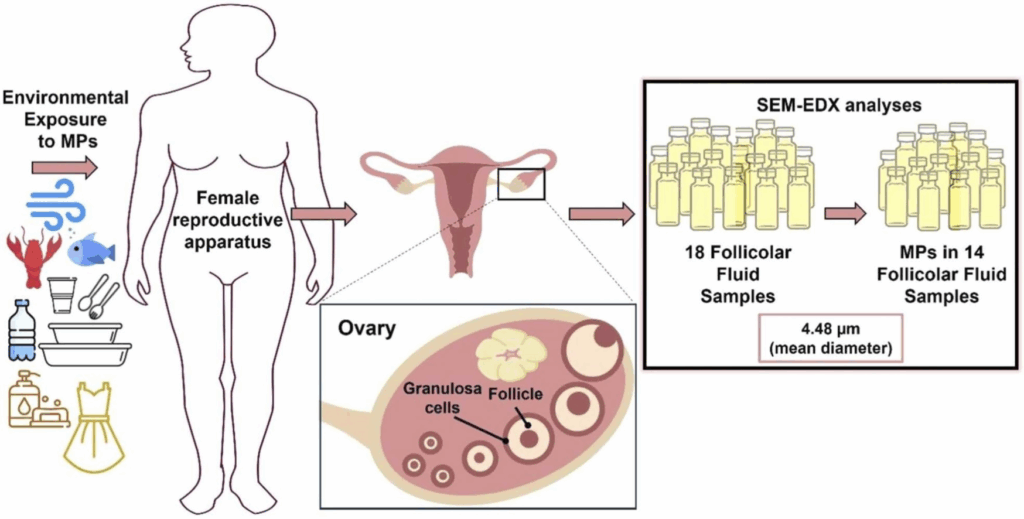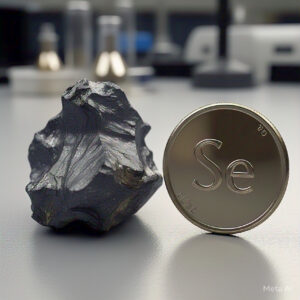
The Food Safety and Standards Authority of India (FSSAI) categorised packaged drinking water and mineral water as a “High-Risk Food category” for stricter quality control. ‘High-Risk Food Category’ includes foods prone to contamination and health risks, requiring strict regulations and frequent inspections for consumer safety. Examples include dairy, meat, seafood, infant food, ready to eat foods and now packaged water.
“Clear Doesn’t Mean Clean: The Plastic Problem in Bottled Water”
Plastics are a part of our everyday lives, and plastic pollution is a growing concern. When plastics break down over time, they can form smaller particles called microplastics, which are 5 mm or less in length—smaller than a sesame seed. Microplastics, in turn, can break down into even smaller pieces called nanoplastics, which are less than 1 μm in size. Unable to be seen with the naked eye, these are small enough to enter the body’s cells and tissues.
A research team led by Drs. Wei Min and Beizhan Yan of Columbia University modified a powerful imaging technique that Min co-invented 15 years ago with NIH support. The technique, called stimulated Raman scattering (SRS) microscopy, is now widely used to visualize small molecules in living cells. Unlike many other methods, SRS microscopy does not depend on labeling specific molecules to find them.
The researchers found that, on average, a litre of bottled water contained about 240,000 tiny pieces of plastic, about 90% of which were nanoplastics. This total was 10 to 100 times more plastic particles than seen in earlier studies, which mostly focused on larger microplastics.
The water contained particles of all seven types of plastic. The most common was polyamide, a type of nylon that’s often used to help filter and purify water. An abundance of polyethylene terephthalate (PET) was also detected. This might be expected, since PET is used to make bottles for water, soda, and many other drinks and foods. Other identified plastics included polyvinyl chloride, polymethyl methacrylate, and polystyrene, which is also used in water purification. The method identified millions of additional particles that did not match the seven categories of plastic. It’s not yet clear if these tiny particles are nanoplastics or other substances.
A study was done in India by a Committee comprising CPCB, ICMR, Central Institute of Petrochemicals Engineering & Technology (CIPET), NCSCM, and other expert institutions, under the Nodal coordination of CPCB stated that microplastics can be categorised into primary and secondary micro plastics – Primary micro plastics are intentionally manufactured in size < 5 mm to be used in various applications such as cosmetics, clothing and other textiles, fishing nets, etc – Secondary micro plastics originate from the breakdown of discarded plastic waste by solar radiation, mechanical degradation, microbial action etc. Microplastic particles may be of various shapes such as fragments, pellets, beads, and fibres


Born with Plastic? Microplastics Detected in the Human Womb
For the first time, using Raman Microspectroscopy, 12 microplastic (MPS) fragments were isolated from human placentas. Five MPS were found on the foetal side, four on the maternal side, and three on the chorioamnionitis membranes, indicating that once inside the human body, these MPS can reach placental tissues at all levels.
Potentially, microplastics may alter several cellular regulating pathways in the placenta, such as immunity mechanisms during pregnancy, growth-factor signalling during and after implantation, and functions of atypical chemokine receptors governing maternal-foetal communication. All these effects may lead to adverse pregnancy outcomes, including preeclampsia and fetal growth restriction
Tiny Plastics, Big Problem: Microplastics Threaten Female Fertility

A potential mechanism that may explain the presence of MPS in the human ovarian follicular fluid is the possibility that MPS pass from the bloodstream to the follicle and thus crosses the blood-follicle barrier, which is a more dynamic and less stable barrier than the blood-testicular barrier, perhaps closer to the placental barrier. Therefore, MPS could enter the ovaries through the circulatory system, reaching the granulosa cells. The ovary is an important reproductive and endocrine organ that produces oocytes and secretes steroid hormones. It is particularly prone to being affected by many environmental substances
References –
- Ragusa A, Svelato A, Santacroce C, Catalano P, Notarstefano V, Carnevali O, Papa F, Rongioletti MCA, Baiocco F, Draghi S, D’Amore E, Rinaldo D, Matta M, Giorgini E. Plasticenta: First evidence of microplastics in human placenta. Environ Int. 2021 Jan;146:106274. doi: 10.1016/j.envint.2020.106274. Epub 2020 Dec 2. PMID: 33395930.
- Montano, L. et al. (2025). First evidence of microplastics in human ovarian follicular fluid: An emerging threat to female fertility, Ecotoxicology and Environmental Safety. Available at: https://www.sciencedirect.com/science/article/pii/S0147651325002040 (Accessed: 26 April 2025).
- https://greentribunal.gov.in/sites/default/files/news_updates/REPORT%20BY%20MOEF%20&%20CC%20IN%20OA%20NO.%20251%20of%202022%20News%20item%20published%20in%20The%20Hindu%20dated%2029.03.2022%20titled%20Detecting%20microplastics%20in%20human%20blood.pdf

Awesome https://t.ly/tndaA
Awesome https://t.ly/tndaA
Awesome https://t.ly/tndaA
Good https://t.ly/tndaA
Very good https://urlr.me/zH3wE5
Very good https://urlr.me/zH3wE5
Very good https://urlr.me/zH3wE5
Very good https://rb.gy/4gq2o4